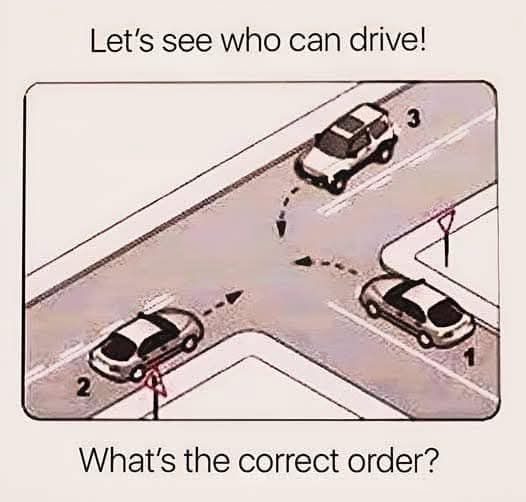Think you know the rules of the road? This simple yet tricky right-of-way riddle has stumped countless drivers. At an intersection, three cars approach from different directions—but who has the right-of-way, and who must wait?
Most people get this wrong, so let’s break it down step by step and see if you can figure out the correct order of movement.

Step 1: Identify the Traffic Signs
Before determining who moves first, look at the signs. The presence of stop signs, yield signs, and traffic lights plays a crucial role in deciding the order of movement.
Here’s what we know about the three cars in this scenario:
✔ Car #1 – Has a yield sign, meaning it must give way to traffic without one.
✔ Car #2 – Also has a yield sign, meaning it must wait as well.
✔ Car #3 – Has no yield sign, which means it has the right-of-way and can proceed first.
With this in mind, we now have our first car to go.
Video: Which car has the right of way? Understand and Resolve this common Right-of-way driving rule
Step 2: Who Goes First? 🚗
Since Car #3 does not have a yield sign, it gets to move first without stopping. In real-life driving situations, cars without stop or yield signs always have priority over those that do.
So, Car #3 takes the lead and moves forward first. ✅
Step 3: Who Goes Next?
Now that Car #3 is out of the way, we’re left with Car #1 and Car #2—both of which had yield signs.
But here’s the important detail:
✔ Car #2 is making a left turn, while
✔ Car #1 is going straight.
According to standard right-of-way rules, a car going straight has priority over a car making a left turn (unless otherwise indicated by signals or signs).
So, Car #1 moves second. ✅
Video: Stop Signs & Right of Way – Part 1 || 4-way stop rules | New Drivers Tips on stop signs
Step 4: The Last Car Moves
Now, the only car left is Car #2, which was turning left. Since both other vehicles have moved, Car #2 is now free to proceed.
So, Car #2 goes last. ✅
Final Order of Movement 🏁
Based on standard traffic laws and right-of-way rules, the correct order is:
1️⃣ Car #3 goes first (no yield sign, has priority).
2️⃣ Car #1 goes second (going straight, has priority over a left-turning car).
3️⃣ Car #2 goes last (must yield when turning left).
So the final answer is 3 → 1 → 2. ✅
Why Do So Many People Get This Wrong?
This right-of-way challenge confuses many drivers because they either:
🚦 Ignore or misinterpret yield signs.
🚗 Forget that left turns must yield to straight-moving traffic.
❌ Assume that arriving first means you get to go first (which is NOT always true).
The truth is, right-of-way laws exist to ensure safe and predictable movement at intersections, and understanding them is crucial for avoiding accidents.
Video: Left Hand Turn Demonstration
Why Understanding Right-of-Way Rules Matters
Following the correct order of movement at intersections is not just about passing a driving test—it’s about avoiding collisions and keeping roads safe.
1. Prevents Accidents 🚧
Misjudging who goes first can lead to dangerous crashes, especially at busy intersections.
2. Reduces Traffic Confusion 🚗💨
When drivers know and follow the rules, intersections flow smoothly and prevent unnecessary delays.
3. Makes You a More Confident Driver 🏆
Knowing when to go, stop, and yield allows you to drive with certainty, making roads safer for everyone.
Final Thoughts: Did You Get It Right?
This simple yet tricky road riddle tests more than just driving knowledge—it challenges your attention to road signs, right-of-way laws, and critical thinking skills.
So, did you guess the correct order? If you got 3 → 1 → 2, congratulations! 🎉 You truly understand who goes first on the road.
Remember—always pay attention at intersections, follow right-of-way laws, and drive safely! 🚗💨